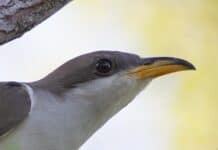Sedona had an unusual visitor come to town on April 19, but it didn’t fit the typical tourist M.O. It was furry and walked on four legs and had not traveled far, nor was it visiting Sedona to goggle over the red rocks or congest the roundabouts throughout town. Rather, it was simply a passerby gaining a little attention on its way out.
A black bear made its first debut this spring, garnering the attention of community members, the Sedona Police Department and of course, the Arizona Game and Fish Department.
While the sighting caused some fright and a little amusement according to Shelly Shepherd, information and education program manager with the Arizona Game and Fish Department, in the last six months this has been the only bear sighting in the Sedona area. Black bear sightings are not a commonality in the area, though some people may believe them to be.
In the rare case that a bear does wander into town, Shepherd said it may be for several reasons, such as food shortages or feeding by people, intentional or otherwise.
“One primary factor that we see is the intentional and unintentional feeding going on by people. Intentional feeding is that people are putting out food for wildlife species and attracting them into the neighborhood,” Shepherd said. “The unintentional feeding really is somebody that may have a bird bath or a bird feeder with seed in it, they feed their cat or dog or other animals outdoors, trash cans that are not sealed properly — all those things may be the unintentional attractant.”
Shepherd also shed light on the drought conditions that the Northern Arizona region has continued to experience over the last few years, which could potentially encourage wildlife like bears to become more active than normal to look for new food and water sources.
Additionally, looking to establish a home range, habitat loss and wildfires could also push bears to travel into town.
“Another factor could be that there is some kind of development or disturbance going on, and we do see some wildlife movement related to that, and that’s because they have been displaced …. Right now, potentially during wildfire season, we have had that occurrence as well where a bear has been displaced by a wildfire,” Shepherd said. “The only other thing I would add is, do we have an animal trying to establish a home range, and that could be a young male bear that is just trying to figure out where it needs to go and get itself established.”
With Northern Arizona in its fire season, if a wildfire were to occur like the Tinder Fire in Payson, there could be potential for bear migration into towns if a fire of that magnitude were to occur elsewhere in the Coconino National Forest.
Being that bears generally come out of hibernation in the spring and become more active in the early summer months as they leave their dens with cubs in search for food, Shepherd advised that people be wary when recreating outdoors. To pre-empt bears wreaking havoc in neighboring forest towns and keep people and wildlife safe, the AZGFD does have a policy and series of procedures in place, which entail monitoring, tagging of animals, possible relocation and last result euthanization.
“As we have had situations dealing with bears and other wildlife species, we definitely have learned from these experiences. That’s what helps us develop our policies and procedures, and we had a revision in about 2015,” Shepherd said.
According to Shepherd, the AZGFD wildlife response policy when dealing with bears includes first monitoring and assessing the situation, then, if necessary, capturing and eartagging the bear or relocating if resources warrant, and last resort, euthanization if the bear is deemed a threat to public safety.
Monitoring and assessment can be based on how many calls they receive from first, second and third parties pertaining to the sighting of a bear or other wildlife species in a reccurring area. AZGFD has a database that allows them to keep track of how many calls they receive regarding any wildlife species, the area of the sighting and how many incidents an animal species may have.
“We need to look for unusual or unacceptable or abnormal behavior — not afraid of humans, entering into the backyard, onto the porch on a regular basis,” Shepherd said.
Further observation of an animal’s behavior may warrant Game and Fish to set a trap to tag a bear or relocate it if necessary. However, the AZGFD is limited on locations and resources for bear relocation. Shepherd noted that relocating a bear out of state is rare. If they put a trap in a certain area they will monitor it to ensure that no people or other wildlife interfere with the trap.
“Typically if we end up capturing or trapping a bear, really our process is we will utilize tranquilizer equipment in a lot of cases; if we get a bear in a bear trap, we will tranquilize after. And the other step is that we do ear-tag them for identification purposes,” she said. “Sometimes we try and get those bears 50 to 100 miles away or more if we can …. We really need to do our homework before we relocate because we don’t want to get a situation where a bear ends up in an area where it injures or kills somebody.”
To halt cases from reaching the euthanization stage, Shepherd circled back to the importance of not feeding wild animals, which is a simple act that can go a long way in saving an animal’s life.
“This is typically the [season] when we see people feeding wildlife, and we want to please tell people do not feed wildlife. It’s only hurting the animal; it’s not helping,” she said.
When recreating outdoors, Shepherd said to remain aware of where one is recreating along with the time of day, as the early morning or late night can be when some animal species like bears can be most active. Shepherd also said she advises people to call the AZGFD’s 24/7 dispatch center hotline at (623) 236-7201 if they spot a bear or other wildlife species in or out of town.
When or if a bear decides to pay a visit to the Sedona area, with a little more knowledge and bearing on how to handle the situation, Shepherd trusts the community and the bear population of Northern Arizona will be just fine.
Makenna Lepowsky can be reached at 282-7795 ext. 126, or email mlepowsky@larsonnewspapers.com


















